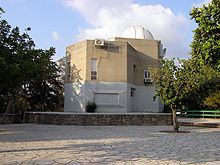History
The Israeli Astronomical Association was established first as an amateur fellowship on May 28, 1951, by a group of astronomy fans immigrating from Germany and Czechoslovakia, among them Dr Heilbruner and Dr Zaichik. Dr Zaichik was the first chairman of the association and kept his position for many years until his retirement due to personal health matters.
The decision to make the association national was made in 1953 in the chamber of David Ben-Gurion, the country's prime minister, in order to promote astronomical knowledge and related science fields in the newly formed state of Israel.
The association was then allocated a territory in Givat Ram in Jerusalem by the Israel Land Administration. The same area was later designated for the development of the Hebrew University of Jerusalem. A planetarium was built for the exclusive use of the association with the financial help of the Williams family from the Palestine bank (later was known as Bank Leumi, Israel National Bank) in 1956.
The main goal of the association was—and still is—the distribution knowledge of the astronomy amongst the Israeli public. This purpose is carried out by organizing conventions, courses, lectures, star parties and observations, as well as publishing the magazine Astronomy (previously All the Stars of Light and The Stars in their Month). This magazine is one-of-a-kind in Hebrew ever since.
In 1953 the association built an observatory in the suburb of Talabia in Jerusalem and started branching all over the country—Tel Aviv, Ramat Gan, Haifa and the Galilee. These branches are no longer active and others will take their place. All the activities of its members were made and are still being made fully voluntarily.
Due to a temporal setback on the activities of the association and the transference of its center of gravity to Givatayim, The Hebrew University of Jerusalem took hold of the planetarium building in 1986, which by then was in the university's expanding territory. The takeover included Albert Einstein's telescope which was given to the association in 1962 from the "Ben Shemen" school. The university turned most of the planetarium site into its office spaces, which brought the association and the Williams family to file two lawsuits against The Hebrew University of Jerusalem (1574/98, 8514/90). These lawsuits were supposed to return the management of the planetarium back to the hands of the association as well as using the planetarium for astronomical purposes. Unfortunately it was decided that in spite of the forceful take-over by the university, the observatory will remain in their custody. Currently the association does not have the resources to maintain the battle and neither the observatory nor the planetarium in Givat Ram do function in their designated purposes.
In 1967, following the Six-Day War, the association inaugurated the Givatayim Observatory in the city of Giv'atayim in the center of Israel. Giv'atayim was the choice of preference due to the height of the place allocated for the observatory, far above the sea level and in distance from its humidity (relative to the surroundings at the time). The observatory was established with the funds of the municipality of Giv'atayim, the association and donations from abroad raised by the observatory manager at the time, Eng. Yossi Fooks. For 25 years the observatory was solely managed by the association. Dince 1994 it had co-management with the municipality of Giv'atayim. The chairmen of the association were sometimes the managers of the observatory at the same time. Among them: Haim Levi, Dr. Noah Brosch (presently the director of the Wise Observatory of Tel Aviv University), Dr. Isaac Shlosman (presently Astrophysics Professor at the University of Kentucky), Ilan Manulis (presently the director of the Technoda Observatory) and Dr. Igal Patel who is the chairman of the association as well as manager of the observatory for over 20 years (ever since 1987).

Amateur astronomy is a hobby where participants enjoy observing or imaging celestial objects in the sky using the unaided eye, binoculars, or telescopes. Even though scientific research may not be their primary goal, some amateur astronomers make contributions in doing citizen science, such as by monitoring variable stars, double stars, sunspots, or occultations of stars by the Moon or asteroids, or by discovering transient astronomical events, such as comets, galactic novae or supernovae in other galaxies.
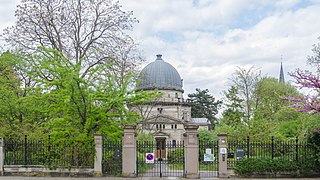
The Observatory of Strasbourg is an astronomical observatory in Strasbourg, France.

Stardome Observatory & Planetarium is a public astronomical observatory and planetarium situated in Maungakiekie/One Tree Hill Domain in Auckland, New Zealand.

Armagh Observatory is an astronomical research institute in Armagh, Northern Ireland. Around 25 astronomers are based at the observatory, studying stellar astrophysics, the Sun, Solar System astronomy and Earth's climate.

Konkoly Observatory is an astronomical observatory located in Budapest, Hungary is part of the Research Centre for Astronomy and Earth Sciences and belongs to the HUN-REN Magyar Kutatási Hálózat. Konkoly Observatory was founded in 1871 by Hungarian astronomer Miklós Konkoly-Thege (1842–1916) as a private observatory, and was donated to the state in 1899. Konkoly Observatory, officially known as HUN-REN CSFK Konkoly Thege Miklós Csillagászati Intézet in Hungarian, is the largest astronomical research institute in Hungary, and hosts the largest telescopes in the country. The Observatory has more than 60 researchers, a quarter of them are non-Hungarian.
The Amateur Astronomers Association of Pittsburgh (AAAP) is an Astronomical Organization founded on June 9, 1929, by Chester B. Roe and Leo J. Scanlon. Since its establishment, it has grown to have over 500 members and operates two observatories in the Pittsburgh region: the Nicholas E. Wagman Observatory and the Mingo Creek Park Observatory. The club also sponsors many star parties that are open to the public throughout the year.
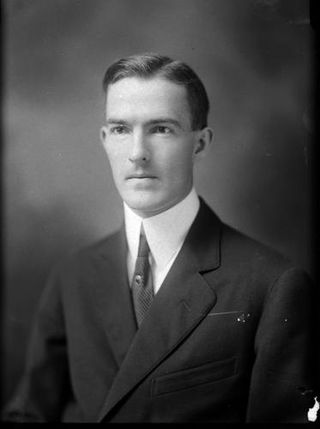
Charles Pollard Olivier was an American astronomer, notable for his contributions to the study of meteors, double stars and variable stars.
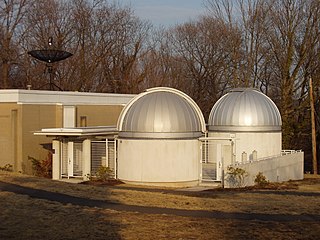
The Yale University Observatory, also known as the Leitner Family Observatory and Planetarium, is an astronomical observatory owned and operated by Yale University, and maintained for student use. It is located in Farnham Memorial Gardens near the corner of Edwards and Prospect Streets, New Haven, Connecticut.
Catharine "Katy" D. Garmany is an astronomer with the National Optical Astronomy Observatory. She holds a B.S. (astrophysics), 1966 from Indiana University Bloomington; and a M.A. (astrophysics), 1968, and Ph.D. (astronomy), 1971, from the University of Virginia. Catharine's main areas of research are massive stars, evolution and formation; astronomical education.

The Archenhold Observatory was named in honour of Friedrich Simon Archenhold, is an observatory in Berlin-Treptow. It houses the Großer Refraktor, which is the longest pointable telescope in the world. It is also called Die Himmelskanone.
The Escambia Amateur Astronomers Association (EAAA) is an amateur astronomy club in Northwest Florida.

The University of Illinois Astronomical Observatory, located at 901 S. Mathews Avenue in Urbana, Illinois, on the campus of the University of Illinois Urbana–Champaign, was built in 1896, and was designed by Charles A. Gunn. It was listed on the National Register of Historic Places on November 6, 1986, and on December 20, 1989, was designated a National Historic Landmark.

Edward A. Halbach was an American amateur astronomer and prolific variable star observer.
The Bareket Observatory is an astronomical educational observatory owned and operated by the Bareket family. It is located east of the city of Maccabim, near Modiin.

The Givatayim Observatory is a public observatory that was founded in 1968 by the Israeli Astronomical Association and the Givatayim municipality.
Khagol Vishwa (KV) is an organization for amateur astronomers working in Maharashtra, India. It was established on 17 November 1999. The main activity of KV is to conduct observations of astronomical events, like meteor showers, eclipses, occultation, variable stars and generate scientific data for amateur research. Along with scientific studies, KV is also active in science popularization. Some of the major activities conducted by KV are public star gazing programs, sky at your doorstep, certificate course in amateur astronomy, and science exhibition.

Astronomical Society Ruđer Bošković is an astronomical society in Belgrade, Serbia. Founded in 1934 by a group of students, it is the oldest one in the Balkans. Initially having only several members, today it gathers more than 700 astronomy lovers. It is named after Ruđer Bošković.

Aryabhatta Research Institute of Observational Sciences (ARIES) is a research institute in Nainital, Uttarakhand, India which specializes in astronomy, solar physics, astrophysics and atmospheric science. It is an autonomous body under the Department of Science and Technology, Government of India. The institute is situated at Manora Peak (elevation 1,951 m or 6,401 ft), about 9 kilometres (5.6 mi) from Nainital, headquarters of Kumaon division.

Elisabeth Miller Bardwell was an American astronomer whose main area of study was meteor showers. She graduated from Mount Holyoke College in 1866, and continued on at the college as an instructor until her death. During those 33 years, she taught a mixture of algebra, trigonometry, physics, and astronomy for the first twenty years, and eventually only astronomy after 1886. She also oversaw the development of the observatory at the college which included invited visits to the Washington, Princeton, Lick, Berlin, and Potsdam observatories. In November, 1891 she was elected a member of the Astronomical Society of the Pacific; in March 1895, of the British Astronomical Association, and in 1898, of the American Association for the Advancement of Science. She was a contributor to Astronomy, Astro-Physics, and Popular Astronomy.
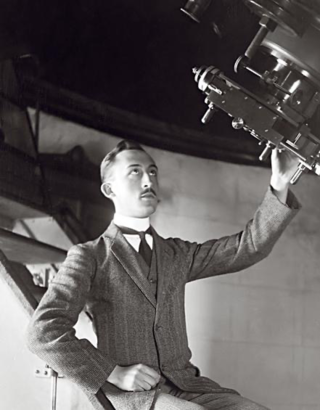
Stavros Plakidis was an astronomer, professor, astrophysicist, mathematician, author, and director of the Astronomical Institute of the National Observatory of Athens and intermittently served as chairman of the National Observatory. He is considered the father of modern astronomy in Greece. Plakidis made systematic observations of variable stars, novae, planets, minor planets, stellar parallaxes, orbits of comets, and double stars, also contributing to the accurate geographic coordinates of the Athens Observatory. Plakidis independently discovered V1500 Cygni several hours after Minoru Honda claimed the find in Japan.
